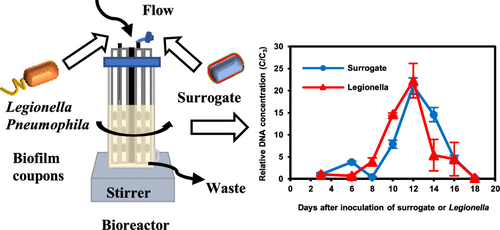当前位置:
X-MOL 学术
›
ACS ES&T Water
›
论文详情
Our official English website, www.x-mol.net, welcomes your
feedback! (Note: you will need to create a separate account there.)
Surface-Modified Biopolymer Microparticles: A Potential Surrogate for Studying Legionella pneumophila Attachment to Biofilms in Engineered Water Systems
ACS ES&T Water ( IF 4.8 ) Pub Date : 2021-08-19 , DOI: 10.1021/acsestwater.1c00144 Sujani Ariyadasa 1, 2 , Gayan Abeysekera 1 , Aruni Premaratne 1 , Beth Robson 1 , Craig Billington 1 , Conan J. Fee 3 , Liping Pang 1
ACS ES&T Water ( IF 4.8 ) Pub Date : 2021-08-19 , DOI: 10.1021/acsestwater.1c00144 Sujani Ariyadasa 1, 2 , Gayan Abeysekera 1 , Aruni Premaratne 1 , Beth Robson 1 , Craig Billington 1 , Conan J. Fee 3 , Liping Pang 1
Affiliation

|
Despite numerous legionellosis outbreaks attributed to contaminated engineered water systems (EWSs), no suitable surrogate has been established for studying Legionella pneumophila in the EWSs. In this study, we developed a novel biopolymer surrogate by using DNA-encapsulated, amino acid-modified alginate–calcium carbonate microparticles. The surrogate mimicked L. pneumophila’s size, rod shape, surface charge, and hydrophobicity. Preliminary proof-of-concept validations were conducted with the surrogate and L. pneumophila in laboratory flow-through biofilm bioreactor experiments with and without chlorine. The 2 entities displayed similar attachment/detachment magnitudes and kinetics to/from Pseudomonas fluorescens biofilms grown on stainless steel piping material. Their relative concentrations and peak attachment values were within the same orders of magnitude, and both exhibited slower attachment than detachment processes. Compared with the experiments without chlorine, surrogate and L. pneumophila biofilm attachment was significantly reduced in the presence of chlorine. P. fluorescens biofilm formation was not affected by exposure to the surrogate microparticles that were made of biocompatible materials. The promising results from our study suggest that further validations of this new surrogate are warranted. It may create new pathways for investigating L. pneumophila mobility and persistence in EWSs, which will facilitate better control of legionellosis risks.
中文翻译:

表面改性的生物聚合物微粒:研究工程水系统中嗜肺军团菌附着于生物膜的潜在替代物
尽管由于受污染的工程水系统 (EWS) 爆发了大量军团菌病,但尚未建立合适的替代物来研究EWS中的嗜肺军团菌。在这项研究中,我们通过使用 DNA 包裹的、氨基酸修饰的藻酸盐-碳酸钙微粒开发了一种新型生物聚合物替代物。替代品模仿了嗜肺军团菌的大小、杆状、表面电荷和疏水性。在实验室流通式生物膜生物反应器实验中,使用和不使用氯对替代物和嗜肺军团菌进行了初步概念验证验证。这两个实体显示出与荧光假单胞菌相似的附着/脱离量级和动力学在不锈钢管道材料上生长的生物膜。它们的相对浓度和峰值附着值在相同的数量级内,并且都表现出比脱离过程更慢的附着。与没有氯的实验相比,在氯存在下,替代物和嗜肺军团菌生物膜的附着显着减少。荧光假单胞菌生物膜的形成不受暴露于由生物相容性材料制成的替代微粒的影响。我们研究的有希望的结果表明,有必要进一步验证这种新的替代品。它可能为研究嗜肺军团菌在 EWS 中的移动性和持久性开辟新途径,这将有助于更好地控制军团病风险。
更新日期:2021-09-10
中文翻译:

表面改性的生物聚合物微粒:研究工程水系统中嗜肺军团菌附着于生物膜的潜在替代物
尽管由于受污染的工程水系统 (EWS) 爆发了大量军团菌病,但尚未建立合适的替代物来研究EWS中的嗜肺军团菌。在这项研究中,我们通过使用 DNA 包裹的、氨基酸修饰的藻酸盐-碳酸钙微粒开发了一种新型生物聚合物替代物。替代品模仿了嗜肺军团菌的大小、杆状、表面电荷和疏水性。在实验室流通式生物膜生物反应器实验中,使用和不使用氯对替代物和嗜肺军团菌进行了初步概念验证验证。这两个实体显示出与荧光假单胞菌相似的附着/脱离量级和动力学在不锈钢管道材料上生长的生物膜。它们的相对浓度和峰值附着值在相同的数量级内,并且都表现出比脱离过程更慢的附着。与没有氯的实验相比,在氯存在下,替代物和嗜肺军团菌生物膜的附着显着减少。荧光假单胞菌生物膜的形成不受暴露于由生物相容性材料制成的替代微粒的影响。我们研究的有希望的结果表明,有必要进一步验证这种新的替代品。它可能为研究嗜肺军团菌在 EWS 中的移动性和持久性开辟新途径,这将有助于更好地控制军团病风险。











































 京公网安备 11010802027423号
京公网安备 11010802027423号